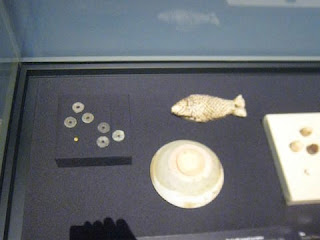Change and Continuity in Humanities
Monday, March 26, 2012
Reflections by Group Members
Darren:The whole journey was though challenging but interesting and eventful. My team was late and rushed to complete the Coleman bridge task. Then we went to the ACM by the wrong route and took longer than others. When we finally reached the ACM, the others already finished their task in the ACM while we had just started. Through this whole journey and completion of the task, I have learnt a lot of new things. I have learnt many new facts about the Artifacts of China and the other Asian countries. I have also learnt that team work at that time was vital as we were very late and had to split the task among one another to complete the task. This learning experience was really eventful and memorable.
Friday, March 23, 2012
~The Ancient Artifacts of China~
 Ewer
EwerChina, probably Henan province, Gongxian kilns, ca. 830 Stoneware
This tall ewer is the most spectacular of the ceramics found on the wreck. Its shape, and details such as the strap across the bass of the handle, are modelled on metalwork. The lozenge motif with leafy fronds encircling the globular body of the ewer is a Middle Eastern design that can be seen on other ceramics from the wreck. The handle terminates at the rim with a snake's head.

Hong Men Membership Tokens
Entrance into a secret society was entering the portals of a shady, complex world of codes, obligations and often violence, as those who crossed the triads found to their peril. These membership tokens were carried around by secret society members, touting slogans like 'Members of the brotherhood should help one another'.


Octagonal Cup With Musicians And A Dancer
China, ca, 830
China, ca, 830
Gold
This is the largest and heaviest example of a rare form of cup. The panels are decorated with muscians and a dancer. They are identifiable aas Central Asian by their long curly hair and billowing clothing. During the 8th and the 9th centuries, such entertainers were popular in China. The ring handle with its bearded faces also show the influence of Central Asian metalware.
 Flask
Flask
 Flask
FlaskChina, ca, 830
Gilded Silver
This sumptuously decorated flack is notable for its size and workmanship. Stylised lotus petals over the entire vessel except for the central medallions, which feature a pair of mandarin ducks, a symbol of marital bliss in Tang China. Attention was paid to every single detail, as seen in the elegant handle formed as a snake.
At The Asian Civilisation Museum

When we first entered the Asian Civilisation Museum after quite a long time walking around and finding for it, we finally made it! As we walked in, the conditioning made us feel much better and comfortable and wondering around under the hot and humid weather. Later, we met up with other teams who had just arrived and collected our free passes. Our journey begins here! :)
@ The Singapore River
Long ago in 1819, the Singapore River was an important route for island's trade and economic activities to take place. The water in the river was also dirty, swampy and occupied with local traders living in raft houses over it. Now, the water has been cleansed thoroughly and I also saw that many fishes live in the waters. There were also activities taking place such as jetty rides where tourists pay to get into the jetty and have a good tour as well as sight seeing along the river. This photo was taken from the internet, so full credits are given to the person :)
Subscribe to:
Comments (Atom)











